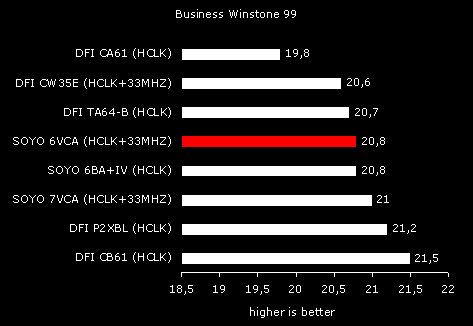
The Quake 3 chart clearly unveils the high gaming performance of
the 6VCA. The tested board again shows excellent performance, almost toping the
fastest boards tested at PCstats. Gamers will be very pleased with the 6VCA's
performance under Quake3.
Overclocking
The 6VCA supports a
wide array of FSB settings and its BIOS even includes manual L2 cache latency
adjustment. As a matter of fact, this is the first motherboard tested in PCi's
labs which sports this feature.
For the benefit of overclocking, the 6VCA
also includes Vcore increase of up to 10% is steps of 2.5% by way of jumper
adjustment. These features make the 6VCA a very powerful overclocking platform
theoretically.
Being a Slot 1 motherboard has its ups and downs: if we
proceed to install a "slocket", we will inevitably generate extra
electromagnetic noise and interference to the CPU signal and this could force us
to increase the CPU voltage in order to get a "cleaner" CPU signal. On the other
hand, we can get more than a 10% CPU voltage increase by using the voltage
setting of the slocket (provided it has a manual Vcore adjustment). So in theory
the overclocking potential of the 6VCA is very promising.
In practice the Soyo 6VCA
confirmed our beliefs with its great overclocking capabilities. We managed to
overclock a Celeron 400MHz to 570MHz by setting the bus speed to 95MHz, the
Vcore to +5% and disabling the +33MHz BIOS option (the PC100 SDRAM we used,
could not work at 95MHz+33MHz=128MHz). The system worked 100% reliably at 570MHz
with all BIOS settings tweaked (with exception of the HOSTCLK memory option).
The other 2 motherboards that were able to achieve this setting 100% reliably
was the Soyo 7VCA
and the Soyo 6BA +IV. The Celeron at 570mhz worked great
for many hours on a hot day without any crashes or lockups.
Subsequently,
we attempted to overclock an FCPGA Celeron 566A to 850MHz but the system refused
to post even when we set the voltage on the slocket at 1.8V (20% over the
default 1.5V). The highest we could squeeze out of the Celeron 566A was 706Mhz
(83x8.5). The same FCPGA Celeron did operate properly at 890MHz only on the Soyo
6BA+IV. However, it is interesting to point out that the Celeron 566A would not
post on ANY of the Via Apollo Pro 133A based boards tested at PCstats. So the
fact that an 850MHz post did not occur with the Soyo 6VCA speaks more of the
chipset itself rather than the potential of the motherboard.
Overclocking
Pentium III Coppermine is a different story. Our primary problem resides
strictly with a Celeron II 566 and the VIA Apollo Pro 133A.
